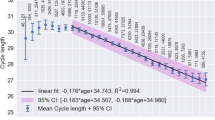Abstract
This was a cross-sectional study that enrolled 160 men aged 50 and above who were sexually active (sexual intercourse in the preceding 6 months) from a large primary care treatment centre. The subjects of interest were elderly aged 65 and above, and men aged 50–65 were used for comparison. The overall response rate was 66.9%. The men who participated were generally more affluent. Standard of living was measured by the presence of maid and housing type. Erectile function (EF) score was significantly higher in those who hired maids (P=0.02). Housing type was not associated with erectile dysfunction (ED). In Model A (included both monthly income and education), significant non-parametric correlations were found between monthly income and EF, intercourse satisfaction (IS), orgasmic function (OF) and sexual desire (SD) domains. After statistical adjustments, only EF (P<0.01) and IS (P=0.04) remained positively associated with monthly income. OF was negatively associated with age (P<0.01) and diabetes (P=0.04), whereas SD was negatively associated with age (P<0.01) in the multivariate analysis. Overall satisfaction was not significantly associated with any factor. In Model B (excluded monthly income from analysis), education attainment was positively associated with OF (P=0.04), but was not significant after adjustment for multiple testing. In the final multivariate model, only monthly income (P<0.01) and age (P<0.01), but not education (P=0.47), remained significantly associated with EF. This study suggests the influence of social determinants on EF and that this influence can extend into late life.
This is a preview of subscription content, access via your institution
Access options
Subscribe to this journal
Receive 8 print issues and online access
$259.00 per year
only $32.38 per issue
Buy this article
- Purchase on Springer Link
- Instant access to full article PDF
Prices may be subject to local taxes which are calculated during checkout
Similar content being viewed by others
Abbreviations
- ED:
-
erectile dysfunction
- IIEF:
-
International Index of Erectile Function
- EF:
-
erectile function
- IS:
-
intercourse satisfaction
- OF:
-
orgasmic function
- SD:
-
sexual desire
- OS:
-
overall satisfaction
- OR:
-
odds ratio
References
Schiavi RC, Schreiner-Engel P, Mandeli J, Schanzer H, Cohen E . Healthy aging and male sexual function. Am J Psychiatry 1990; 147: 766–771.
Phanjoo AL . Sexual dysfunction in old age. Adv Psychiat Treat 2000; 6: 270–277.
Kinsey A, Pomeroy W, Martin C . Sexual Behavior in the Human Male. W.B. Saunders: Philadelphia, 1949.
Kaiser FE, Viosca SP, Morley JE, Mooradian AD, Davis SS, Korenman SG . Impotence and aging: clinical and hormonal factors. J Am Geriatr Soc 1988; 36: 511–519.
Schiavi RC, Schreiner-Engel P, Mandeli J, Schanzer H, Cohen E . Healthy aging and male sexual function. Am J Psychiatry 1990; 147: 766–771.
Feldman HA, Goldstein I, Hatzichristou DG, Krane RJ, McKinlay JB . Impotence and its medical and psycho-social correlates: results of the Massachusetts Male Aging Study. J Urol 1994; 151: 54–61.
Bacon CG, Mittleman MA, Kawachi I, Giovannucci E, Glasser DB, Rimm EB . A prospective study of risk factors for erectile dysfunction. J Urol 2006; 176: 217–221.
Ayta IA, McKinlay JB, Krane RJ . The likely worldwide increase in erectile dysfunction between 1995 and 2025 and some possible policy consequences. BJU Int 1999; 84: 50–56.
Berkman LF, Kawachi I . A historical framework for social epidemiology. In: Berkman LF Kawachi I (eds). Social Epidemiol. Oxford University Press: Oxford, 2000, pp 3–12.
Census and Statistics Department. Hong Kong Population Census 2001. Hong Kong SAR.
Leung SF, Arthur D . The alcohol use disorders identification test (AUDIT): validation of an instrument for enhancing nursing practiced in Hong Kong. Int JNurs Stud 2000; 37: 57–64.
Chiu HF, Lee HC, Wing YK, Kwong PK, Leung CM, Chung DW . Reliability, validity and structure of the Chinese Geriatric Depression Scale in a Hong Kong context: a preliminary report. Singapore Med J 1994; 35: 477–480.
Ng ML, Ho R . Erectile function of Chinese men with schizophrenia in psychiatric out-patient clinics and their attitude towards treatment. Sex Health 2004; 1: 35–38.
Department of Health. Topical Health Report No. 3 Elderly Health 2004. Elderly Health Services, Disease Prevention and Control Division.
Buss DM . Sex differences in mate preferences: evolutionary hypotheses tested in 37 different cultures. Behav Brain Sci 1989; 12: 1–49.
Akkus E, Kadioglu A, Esen A, Doran S, Ergen A, Anafarta K, et al., Turkish Erectile Dysfunction Prevalence Study Group. Prevalence and correlates of erectile dysfunction in Turkey: a population-based study. Eur Urol 2002; 41: 298–304.
Tan JK, Hong CY, Png DJ, Liew LC, Wong ML . Erectile dysfunction in Singapore: prevalence and its associated factors – a population-based study. Singapore Med J 2003; 44: 20–26.
Aytac IA, Araujo AB, Johannes CB, Kleinman KP, McKinlay JB . Socioeconomic factors and incidence of erectile dysfunction: findings of the longitudinal Massachussetts Male Aging Study. Soc Sci Med 2000; 51: 771–778.
Morillo LE, Diaz J, Estevez E, Costa A, Mendez H, Davila H et al. Prevalence of erectile dysfunction in Colombia, Ecuador, and Venezuela: a population-based study (DENSA). Int J Impot Res 2002; 14: S10–S18.
Safarinejad MR . Prevalence and risk factors for erectile dysfunction in a population-based study in Iran. Int J Impot Res 2003; 15: 246–252.
Author information
Authors and Affiliations
Corresponding author
Rights and permissions
About this article
Cite this article
Cheng, J., Ng, E., Ko, J. et al. Monthly income, standard of living and erectile function in late life. Int J Impot Res 19, 464–470 (2007). https://doi.org/10.1038/sj.ijir.3901537
Received:
Revised:
Accepted:
Published:
Issue Date:
DOI: https://doi.org/10.1038/sj.ijir.3901537



